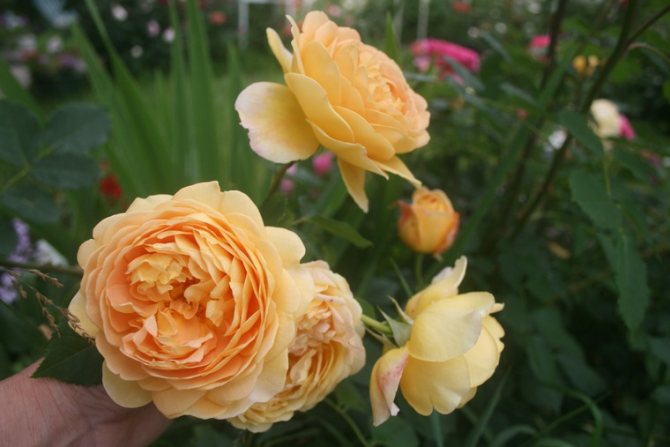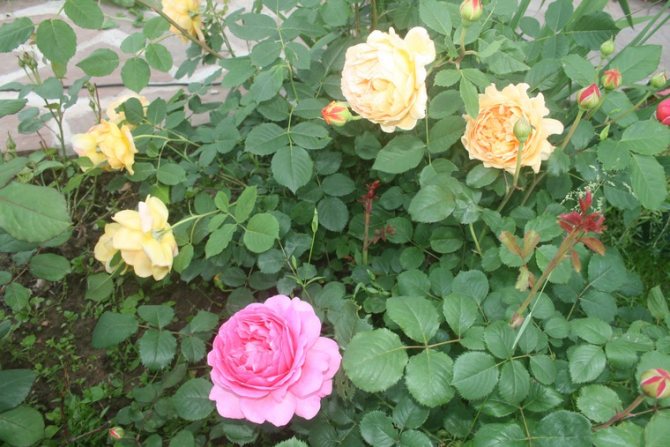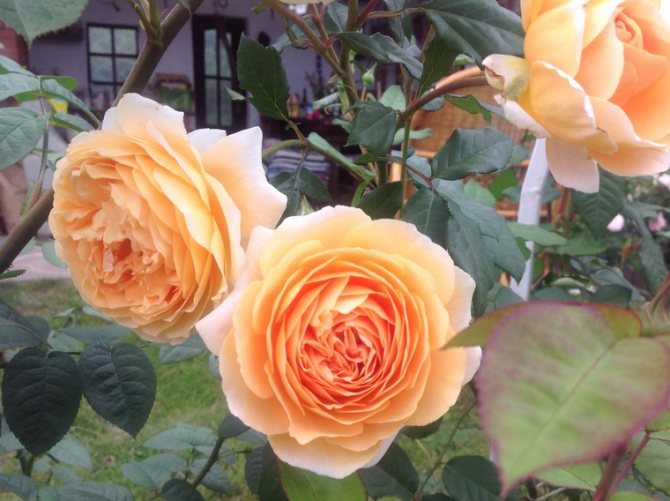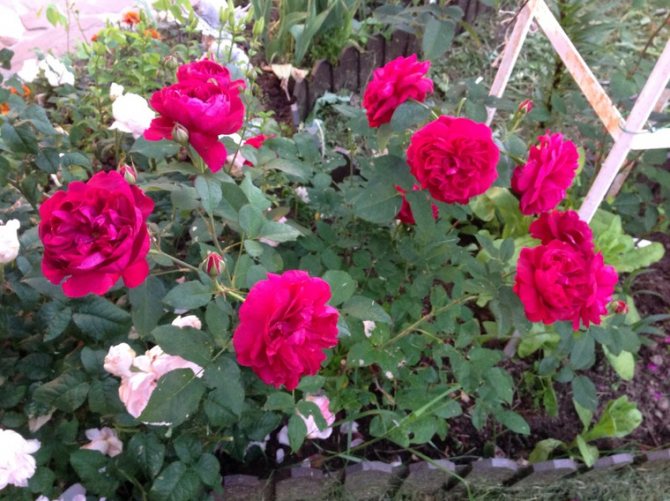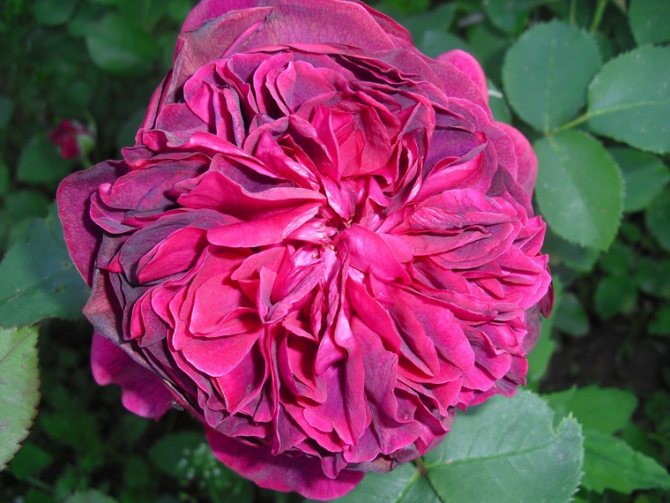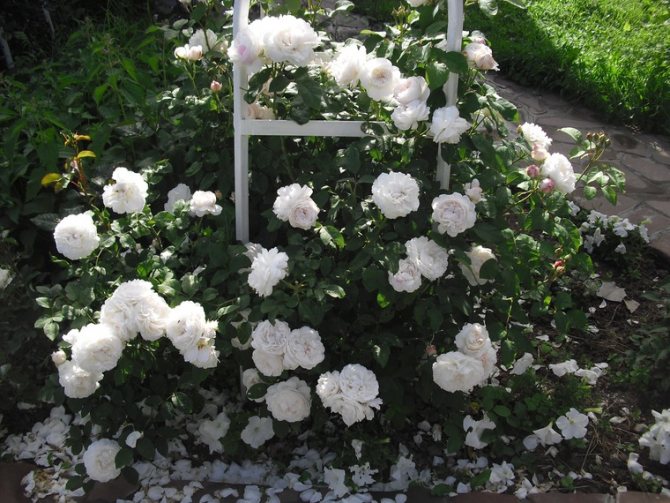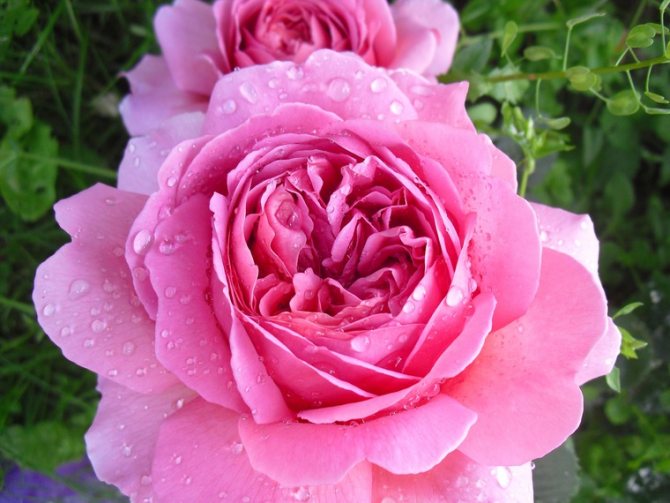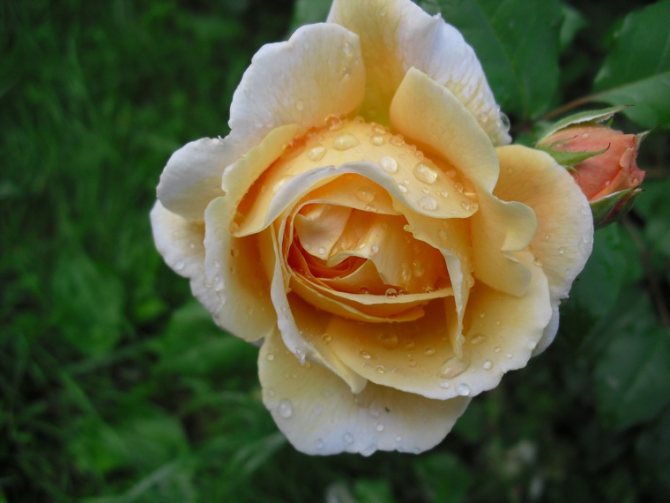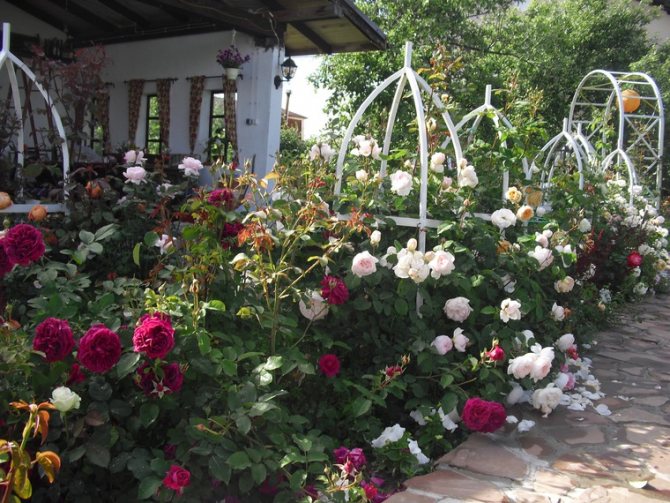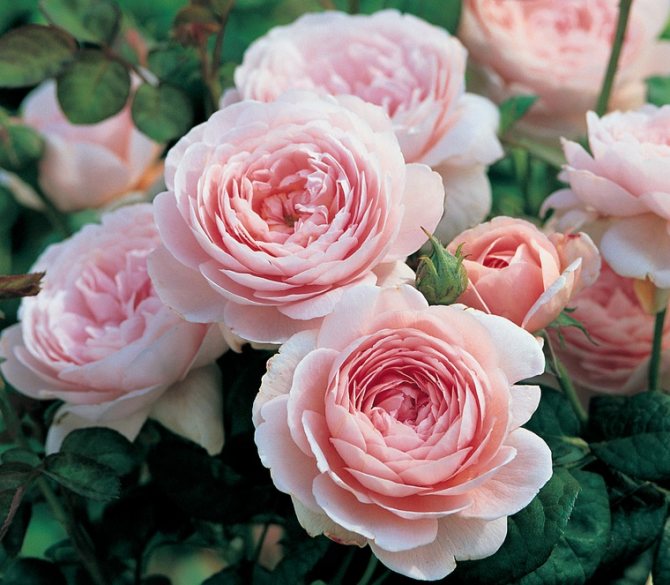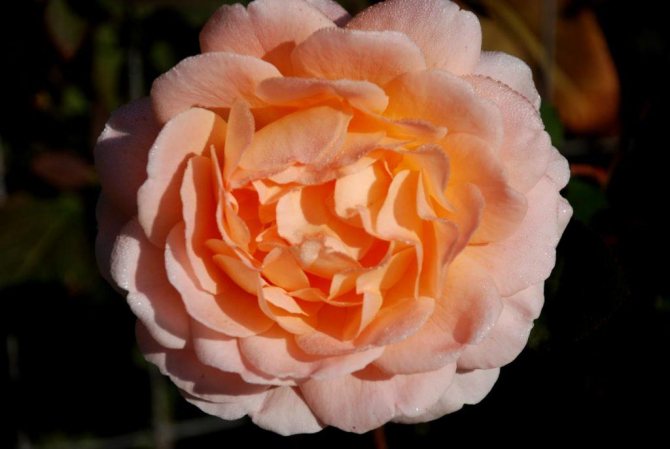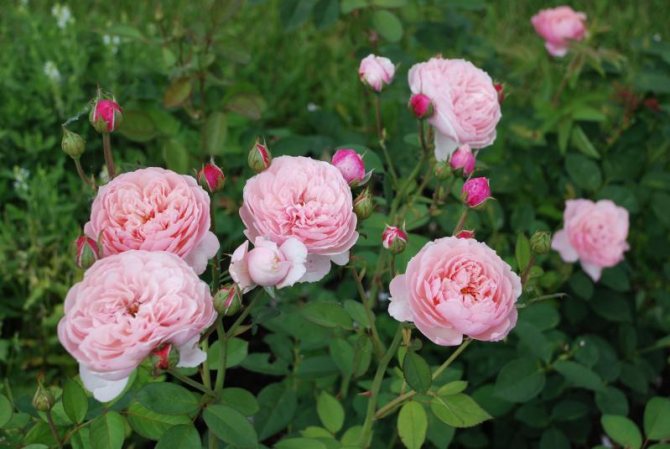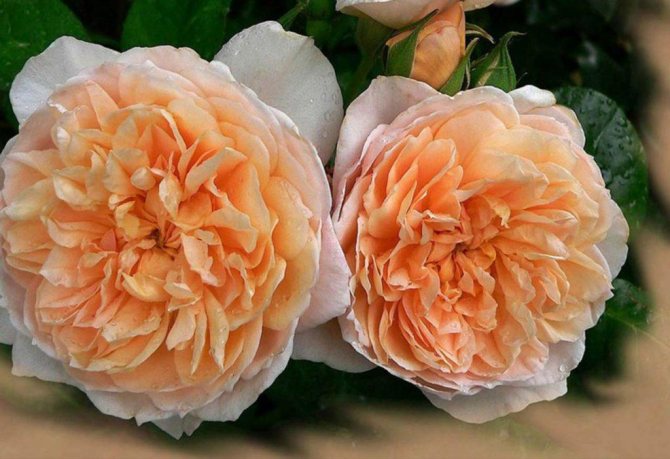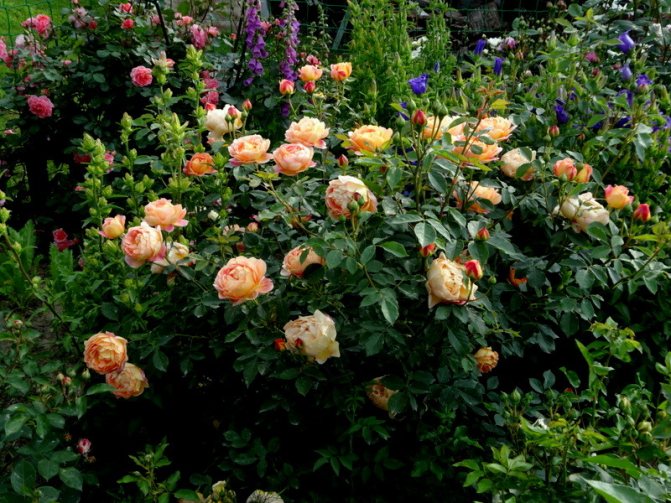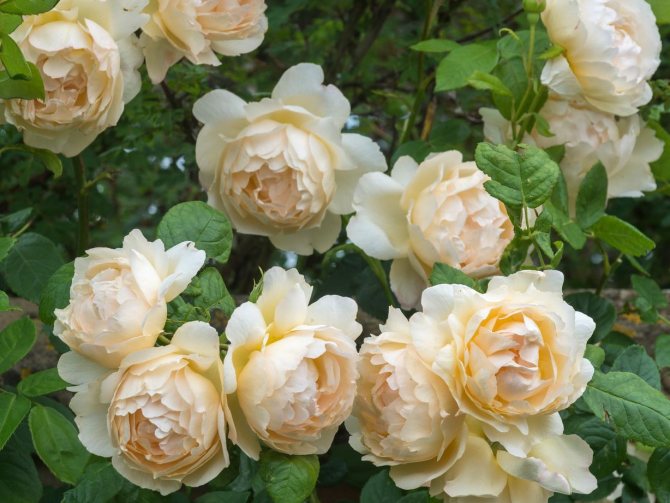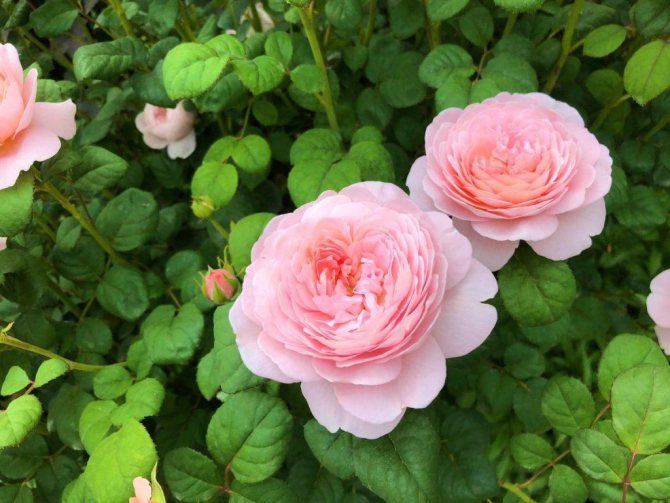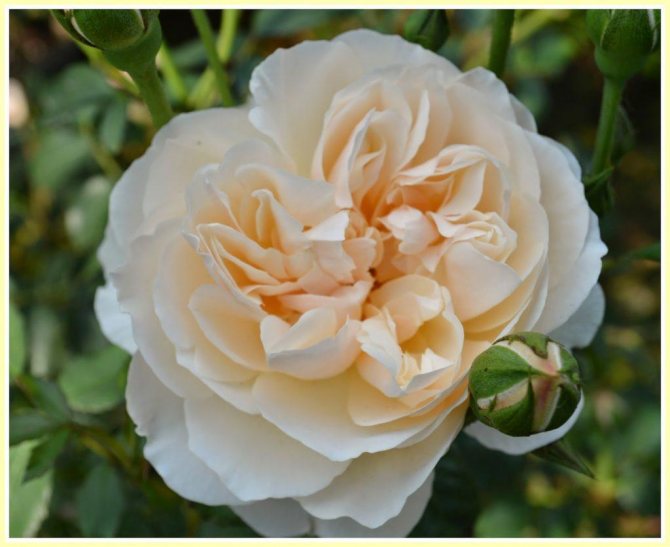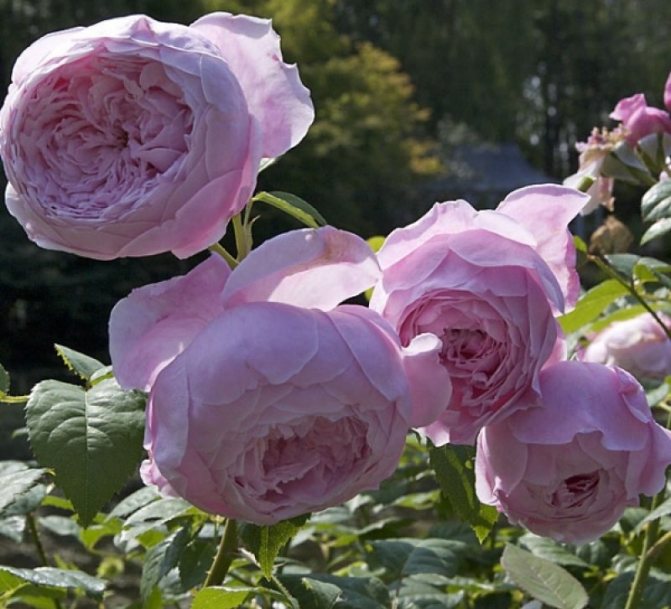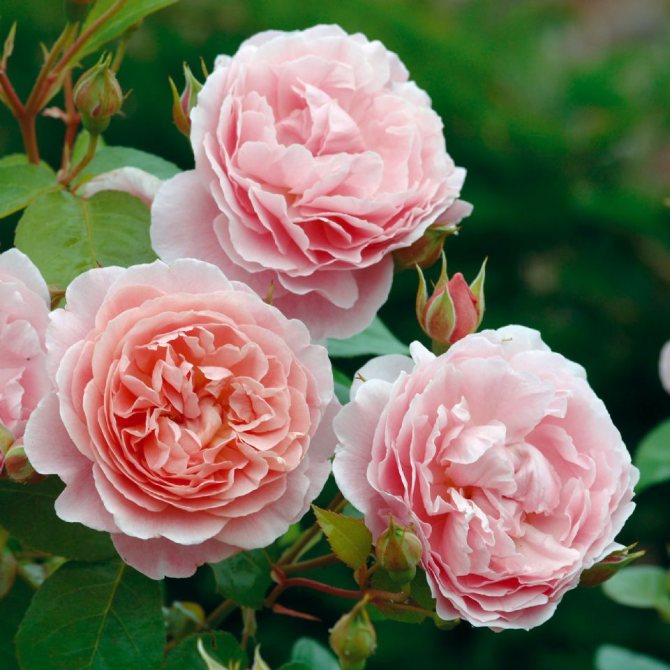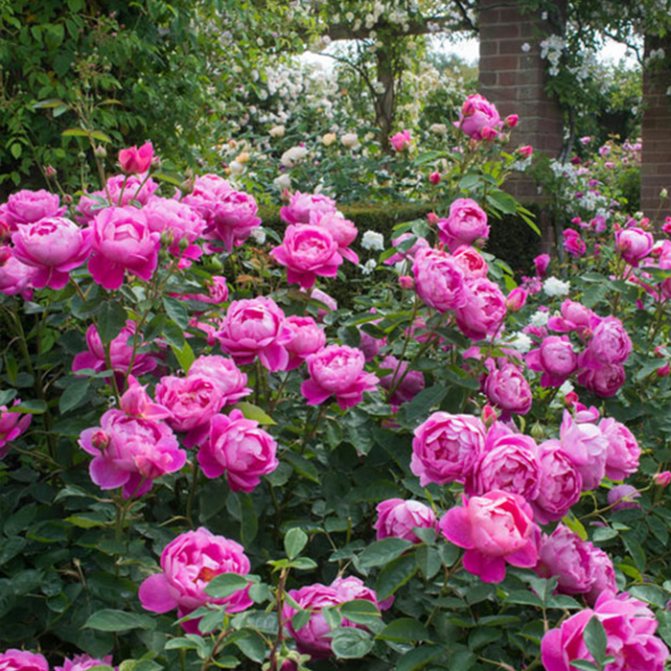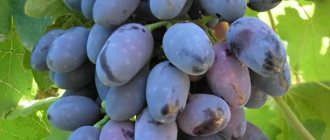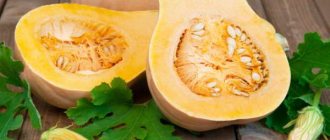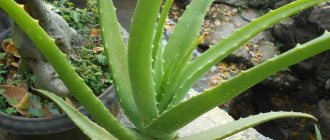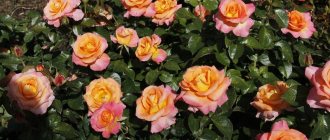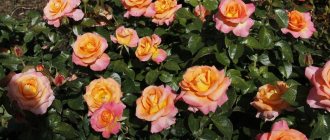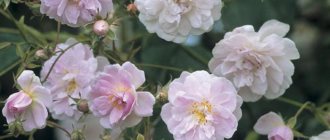Austin roses are common among gardeners. Currently, there are more than two hundred species of these representatives of Rosaceae.
Austin roses gained such popularity due to their large bright buds, reminiscent of classic English roses in style, wonderful aroma, ease of care and high resistance to various diseases.
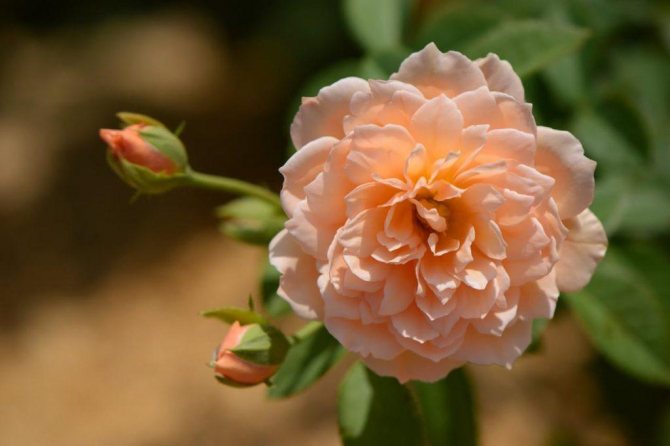
David Austin: description and characteristics of flowers
David's roses are also called "Ostinki". Their characteristic features include the formation of not only a beautiful, but also a large flower, resistance to diseases and an excellent aroma that the plant exudes during flowering. This is what the great breeder wanted to achieve.
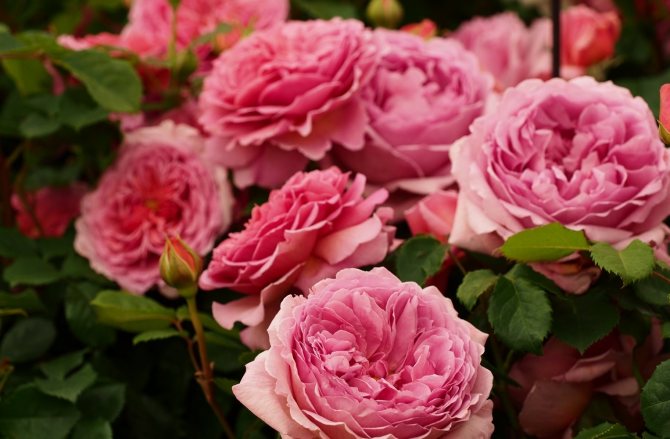

Roses by David Austin
All varieties of his roses are formed by a neat bush. They grow in almost all climatic conditions, bloom several times during one growing season (subject to agrotechnical rules).
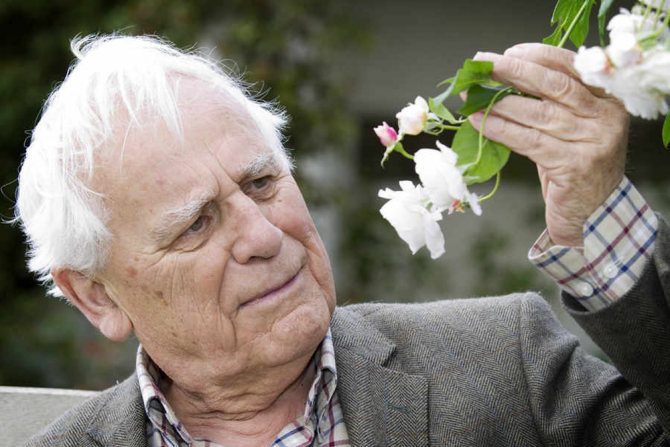

Breeder David Austin
Advantages and disadvantages of varietal flowers
David Austin roses have many advantageous features that outweigh the disadvantages.
The main advantages in comparison with other varieties:
- Excellent indicators of frost resistance (plants are actively grown in Russia, for example, in the Moscow region).
- Flowers form along the entire stem, which visually gives the impression of a lush flowering bush.
- The flowers are characterized by a peony shape.
Note! Ostinka roses have received numerous official international awards.
As for the disadvantages, it is worth highlighting the instability to precipitation. Prolonged precipitation provokes rotting of the buds. At high temperatures, the flowers decrease in size, the saturation of the shades fades.
Origin story
Initially, there was nothing English in English roses, except for the name of their author - the farmer David Austin. To create them, he was pushed by the appearance of old French roses, and the first famous variety was also bred by Austin on the basis of an old Gallic variety (again from France).
The idea of a grower to revive the beauty and charm of roses from earlier centuries, giving them the ability to bloom twice inherent in modern varieties, turned out to be fruitful. So a little more than half a century ago, the "firstborn" from a series of English roses was born - the Constance Spry variety.
Did you know? Rose oil is superior in value not only to gold, but also to platinum. To obtain a whole liter of this product, you will need 3 tons of the lightest petals.
The best varieties of roses by David Austin
Terry geranium - the most popular varieties
Rose "Austina" has several varieties, the most popular are the following varieties.
Jubilee Celebration
A characteristic feature is the formation of pink densely double inflorescences with a golden tint. Their diameter, as a rule, reaches 7 cm, the height of the bush is about 50-70 cm. During flowering, it exudes an unsaturated fruity aroma, with pronounced citrus notes. Leaves change color from reddish-green to green as they develop.
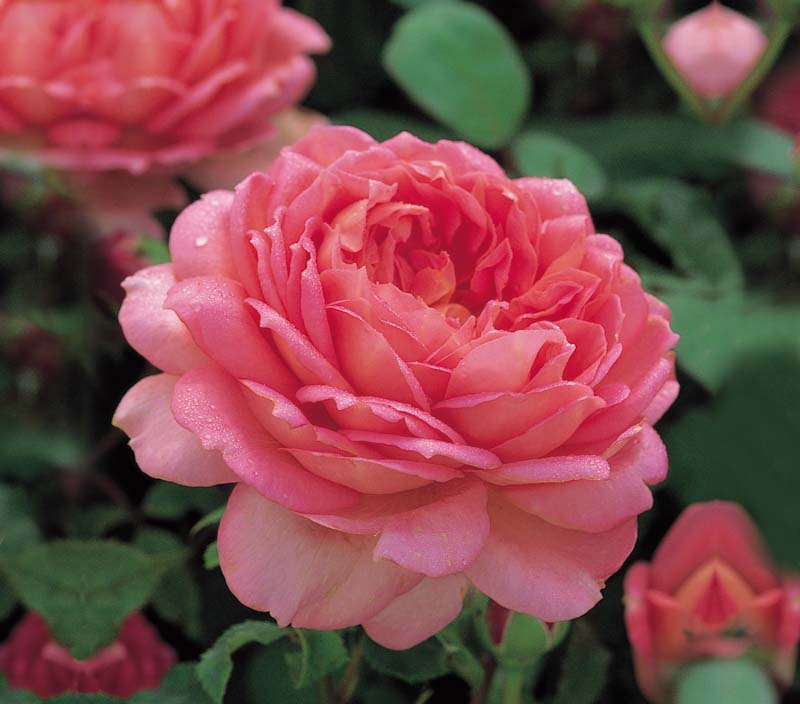

Jubilee Celebration appearance
The culture is resistant to powdery mildew and other infections. Blooms subject to agrotechnical rules from mid-June to September.
Jude the Obscure
Roses Jude ze Obscur are incredibly delicate, peach color, large sizes. The bushes are resistant to pest attacks and disease development. During one growing season, they can bloom 2-3 times.
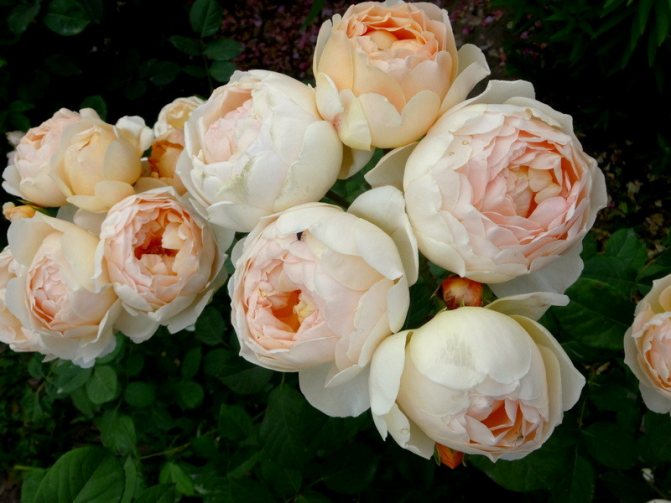

Jude the Obscure
Golden Celebration
A characteristic feature of the variety is excellent disease resistance. During flowering, bright yellow large flowers are formed, on each stem there are about 5 buds. The bush blooms twice in one growing season, reaching a height of 1.5 meters.
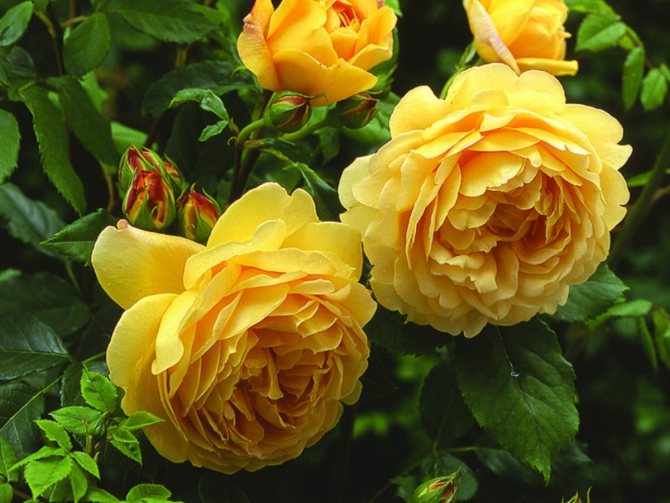

Roses Golden Celebration
Christopher Marlowe (Christopher Marlowe)
The variety was named after the English poet. The plant has a bright pink color with an orange core. Sizes in diameter reach 9 cm. Leaves are especially resistant to aggressive environmental factors. Blooms throughout the summer.
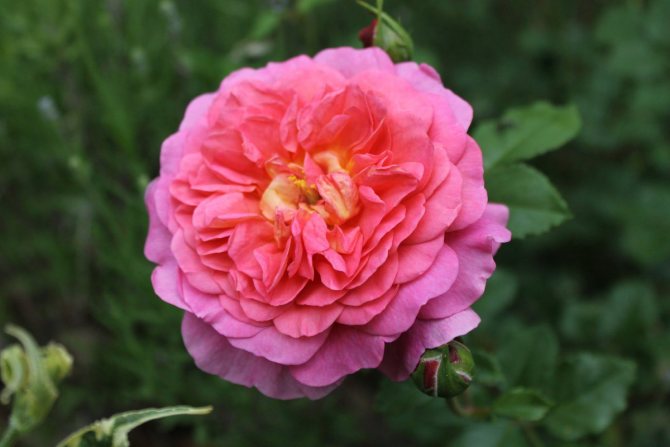

Christopher Marlowe rose appearance
Lady of shalott
This variety is distinguished by excellent indicators of endurance and frost resistance. During flowering, large golden salmon flowers with a rich apple aroma are formed. The height reaches 1-1.2 meters. Blooms twice during the summer. Suitable for growing in the harsh climatic conditions of Siberia. You can grow it as a climbing culture.
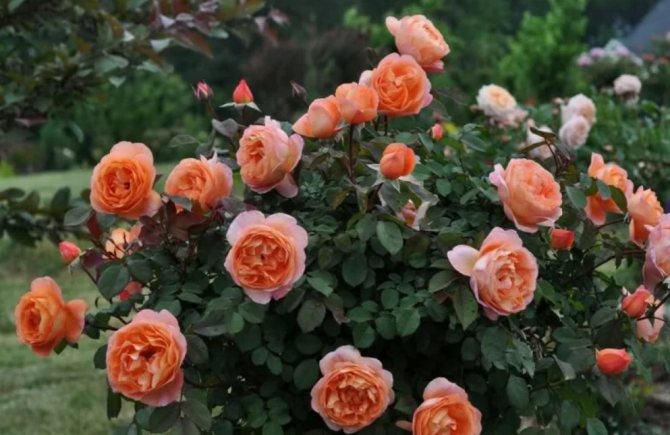

Rose Lady of Shallot
Abraham Darby
This variety thins out the delicate fruity aroma during flowering. On the bushes, medium-sized light pink inflorescences are formed. The crop is resistant to black spot and powdery mildew. A flowering plant is quite easy to care for.
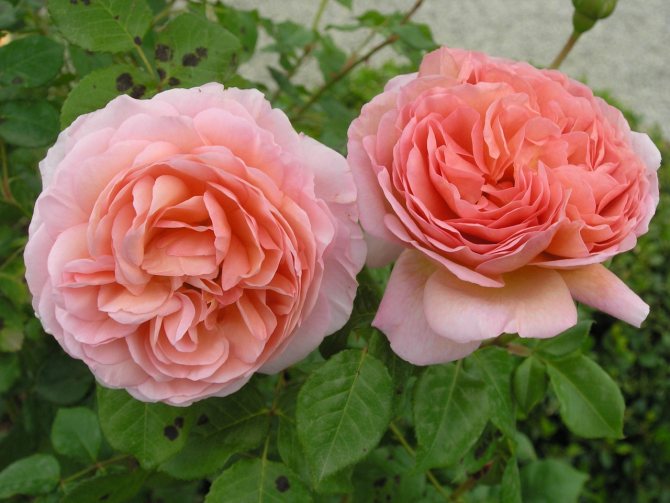

Exterior of Abraham Darby
Important! The stems can fall under the weight of the flowers, so it is worth taking care of creating a support.
Molineux
This plant, during flowering, forms a flower of medium size and rich light yellow color. The culture is resistant to the harmful effects of rainfall. In favorable climatic conditions, the height of the bushes can reach two meters. Blooms with brushes.
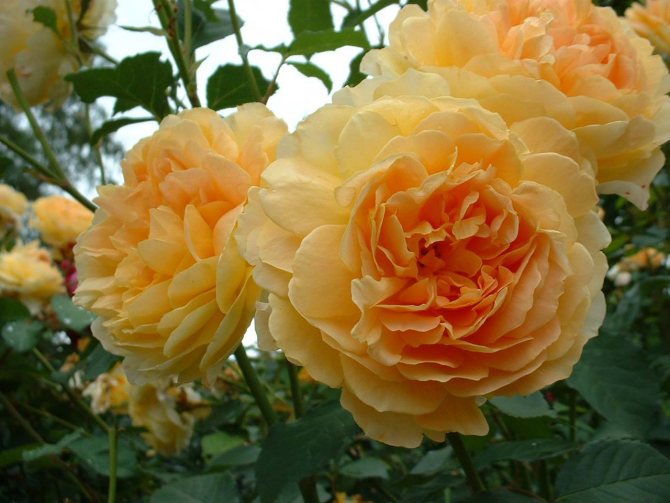

Rose Molyneux
Wollerton Old Hall
The height of the bush reaches 1.5 meters, blooms without interruption throughout the growing season. Large flowers in creamy tones are formed.
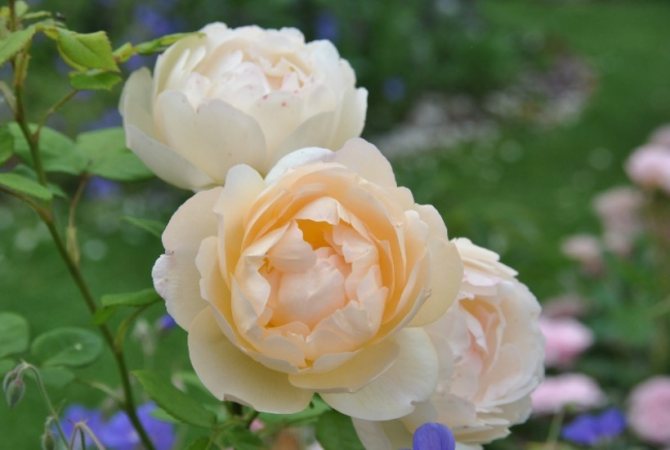

Wollerton Old Hall
Crown Princess Margareta
A bush with large roses of rich peach color. Designed for growing in unfavorable climatic conditions, they are considered one of the most hardy plants.
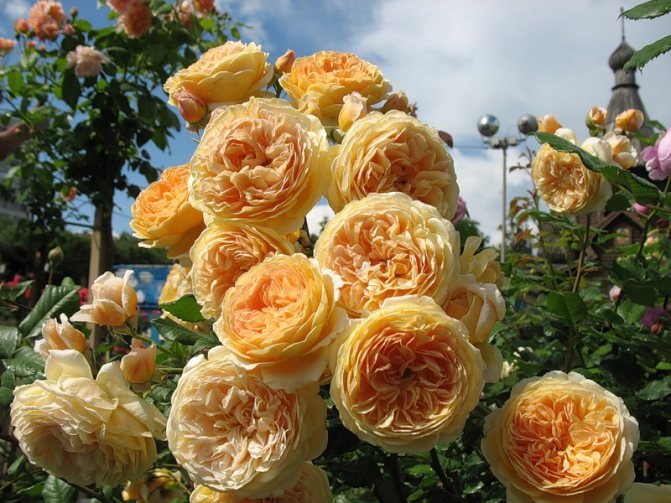

Crown Princess Margareta
Teasing Georgia
During flowering, a large rose of pale yellow or white color is formed with a rich fruity or sweet aroma. On the stems, thorns are practically absent, indicators of resistance to diseases are average.
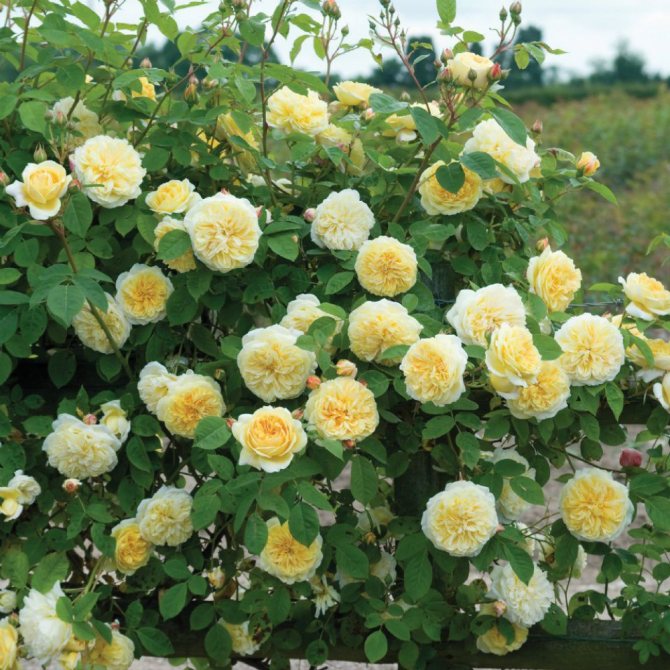

The appearance of the Tizine Georgia rose
Growing and caring at home
Caring for this rather unpretentious plant consists in:
- watering;
- feeding with organic and mineral fertilizers;
- pruning;
- weeding;
- loosening the soil;
- disease prevention and pest control;
- preparation for wintering.
Fertilization and watering
If the soil around the plant has dried out to a depth of 3 cm, watering is required, which is preferable to carry out in the evenings. A simple rose bush requires at least a bucket of settled water (and if the rose belongs to the climbing varieties, then it needs one and a half buckets). At the end of August, watering is stopped, and if the summer is damp, this should be done at the end of July.
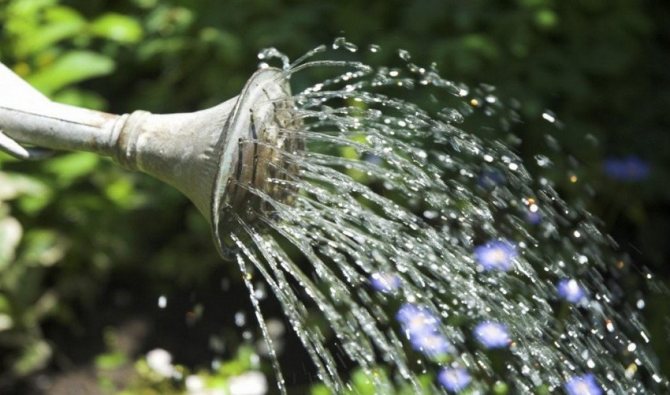

Since the pink seedling is placed in well-fertilized soil, there is no need to feed it in the first year of life. The next year, in the spring, nitrogen-rich organic fertilizers are applied under the plant in the form of a solution of mullein or bird droppings to stimulate the growth of green mass.
Mullein is bred in water in a ratio of 1: 10 and droppings - 1: 20.During budding, the rose already needs more calcium and phosphorus fertilizers, and in the fall, potash fertilizers will be even more useful, helping the plant to winter safely.
Important! When applying fertilizers, do not overdo it, as excess fertilization can cause yellowing and leaf fall.
Pruning
The English rose is pruned in the spring before the buds swell and in the fall to free them from overly thin, dry, unhealthy-looking and poorly developed shoots. Autumn pruning also allows you to make a better shelter for the plant for the winter.
The degree of pruning also depends on its goals. To grow a shrub of small height, but with large flowers, the shoots should be cut to half their length, and to grow a spreading bush with numerous buds, it is enough to shorten the branches by a third.
Curly roses with long lashes are made shorter by only a fifth of the original length. The most popular form for the shrubs of these pink plants is the hemisphere.
Weeding
Weeding, combined with loosening the soil around the bush, not only frees the rose from weeds that steal nutrients from it, but also facilitates the access of air and moisture to its roots. Loosening should not be carried out too deep, so as not to damage the thin root system of the plant.
After such a procedure, it is useful to mulch the soil around the bush with peat or humus (up to 0.1 m high). This will improve the structure of the soil and make it easier for the rose to absorb nutrients.
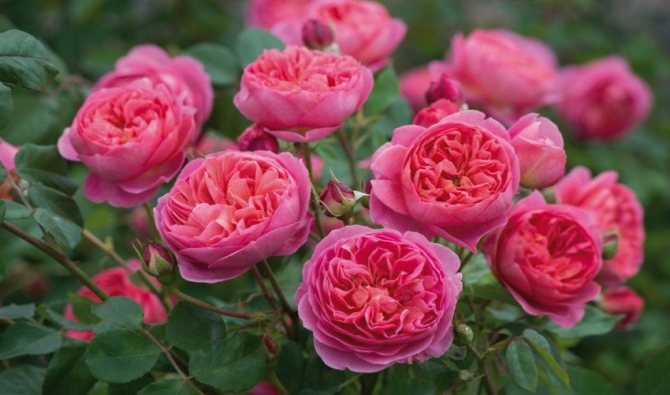

Disease and pest control
If you create optimal conditions for the English rose, it can grow in the same place for over 20 years.
For all its resistance to most diseases and pests, this plant can be exposed to fungal and viral diseases, most often represented by:
- powdery mildew;
- rust;
- gray rot;
- viral mosaic;
- black spot;
- peronosporosis.
These diseases are prevented by scrupulous adherence to agrotechnical rules, as well as preventive measures in the form of spraying the bushes with aqueous solutions of wood ash in a ratio of 1:10, mullein in the same proportion or potassium permanganate, 2.5 g of which is diluted in a bucket of water.
Pollination of bushes and sprinkling of soil around them with wood ash is very efficiently carried out twice a season.
And if the bushes have already begun to be affected by fungi or viruses, it is necessary to spray them every 5 days with one percent Bordeaux liquid or soap-copper solution prepared from 300 g of laundry soap and 20 g of copper sulfate, diluted in a bucket of water.
These plants can be attacked by pests represented by:
- green aphid;
- leaf roll;
- spider mite;
- thrips;
- sawfly.
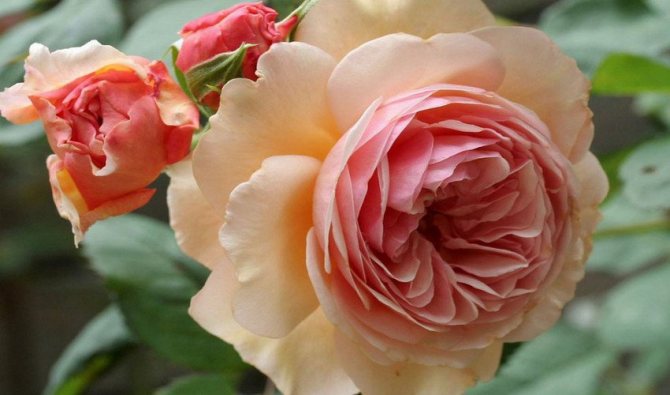

In this case, the bushes should be treated with insecticidal preparations.
Did you know? The wild rose bush growing in Germany near the Cathedral of Hildesheim still blooms today, although it is almost 1000 years old. It has grown so much that it is already equal to the roof of the building.
English rose care
It is recommended to water the plant in the evening, the water should not be cold. After rains, the remnants of moisture must be shaken off the leaves and buds, otherwise the decay process may begin. The soil needs to be loosened periodically.
Dutch roses - varieties, how they are grown
Fertilizing is necessary if the plant is older than 1 year. Such bushes are fertilized at intervals of 3-4 weeks throughout the growing season. If the bush needs to be transplanted, then this is done after pruning.
Important! For the winter, the flowering culture is covered with sawdust and earth, after sprinkling the near-stem circle with poison for rodents.
Growing conditions
As mentioned above, English roses prefer moderate temperatures, do not like heat, and in winter they need shelter from frost. They are quite shade-tolerant, they are quite enough for four hours of sunlight.
Although the growers emphasize that in more illuminated areas, the shoots are not stretched so intensively. Originally from foggy Albion, these roses easily tolerate humid air, and the same is true of the soil.
Important! These plants do not tolerate waterlogging of the soil, therefore, the territory in which they grow should in no case be flooded with melt water.
English roses do not make great demands on the quality of the soil, but they grow better on breathable soils, rich in humus with an acidic value of up to 6.5 pH.
Flower propagation
These varieties of roses are propagated exclusively by grafting, dividing and grafting.
The most reliable and common way is grafting. The most suitable time for it is during the flowering stage in early summer. Having planted strips of seedlings, it is important to observe the optimum level of soil moisture, and for the winter it is imperative to cover with insulating fiber.
David Austin's roses are a real work of art. Some of them are wayward and capricious, but this does not stop many gardeners. Rose lovers are attracted by Falstaff, Master red, Juliet, Kent Alexander, Winchester and Rosalind.
Description
In 1950, David Austin in France noticed ancient rose bushes with a unique flower appearance and a pleasant strong scent. Inspired by its beauty, he wanted to create a modern variety that combines the characteristics of forgotten types of roses. and will meet new plant requirements, including resistance to adverse weather conditions. The main task was to give new bushes the ability to re-bloom and develop in different climatic zones. Old types of roses are distinguished by the absence of warm shades in the yellow range, which the breeder also wanted to change.
The crossing of Bel Isis and Le Grasse in 1961 led to the creation of Austin's first Constance Spray rose. It belongs to the peony varieties. Its large, cupped flowers are pink in color and have a persistent aroma. "Constance Spray" dissolves the buds only once a year, but has gained great love among gardeners and remains relevant and popular these days.
"Bel Isis"
Constance Spray
In 1984, about 50 plant varieties were already presented, which appeared through the selection of old species with hybrid tea roses., floribunda group, wild rose. Austin varieties in appearance resemble Damascus, Bourbon, Gallic, Albu, but differ in a wide color palette, the ability to grow on depleted soils, and resistance to poor environmental conditions. With outward old-fashionedness, most of their species are re-flowering, some are capable of multiple continuous flowering. The main plus is the reduced demand for lighting, 4 hours of daylight are enough for roses to develop.
All Austin cultures have buds like old rose bushes - cupped, rosette, pompom. Cone-shaped flowers (the shape is inherent in the hybrid tea species) David rejected during crossing. Each variety is distinguished by its rich aroma. The name "Jude the Obscur" is assigned to the most fragrant Austin rose, its scent is able to compete with real French perfume.
About 4 new crop varieties are recorded every year. Among them were bred shrubs, erect tall, dwarf bushes with small flowers, suitable for growing in closed ground, containers.
"Sins of Thomas"
Roses "Graham Thomas" were bred in 1983. This is the most popular variety of English roses in terms of color. These roses are also considered to be one of the best varieties. The Royal National Rose Society has appreciated both the beauty and characteristics of this species.
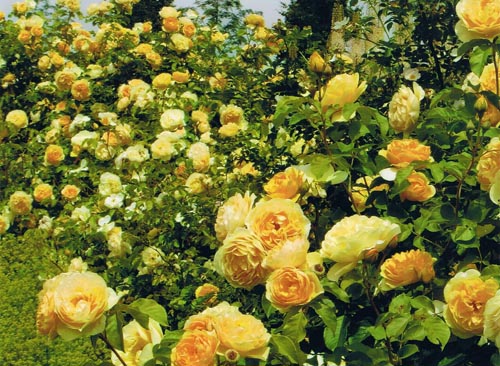

Graham Thomas has a pure deep yellow color. The buds can be yellow or peach in color. This is what gives roses such charm and beauty.Terry cupped flowers have the scent of a tea rose and reach a size of 10 centimeters, collected in a brush. Each bud has over 70 petals, when they all open, the rose looks very lush.
The bushes have a beautiful shape and throughout the summer period please the eye with their flowering. In cold regions, they reach a height of one and a half meters. In countries with hot climates, they can grow twice as high. Roses are unpretentious, disease resistant. These beautiful flowers, like all varieties of English roses, need timely pruning.
Features of planting Shakespeare roses on the site
These flowers have their own planting characteristics. The initial planting procedures for regular roses do not apply at all to English ones. Before planting, the sprouts are soaked in water with nutrients dissolved in it. They stimulate the growth and development of the root system. Then they choose a landing site.
Features of choosing a landing site:
- Bright light is undesirable for plants. 5 hours of sunshine is enough for roses to develop well. The rest of the site should be shaded.
- The chosen place should not be empty of snow in winter and becomes a site for the accumulation of melt water in the spring. It is best to land next to gazebos, verandas, terraces, fences and other structures.
When the location is selected, you can prepare a pit for disembarkation. The depth, width and length of the hole should be 50 cm. The soil should be fertile garden mixed with humus. 10 liters of water are poured into each hole, and leave the hole for a day.
When planting, it should be borne in mind that the grafting site should be located at a depth of no more than 70 cm. Then the roots should be evenly spaced in the pit.
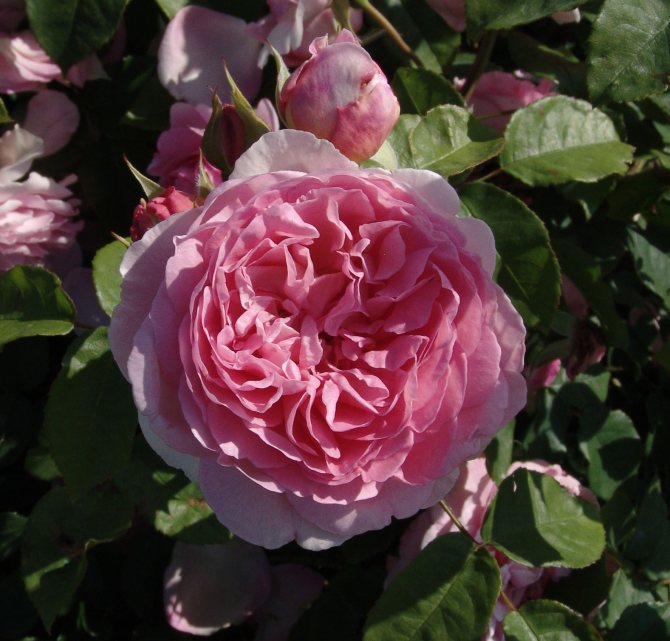

On the first day, it is required to water each bush with 45 liters of water. Further, the soil will require hilling. Only in this way will all the conditions for the correct development of the roots and its processes be met.
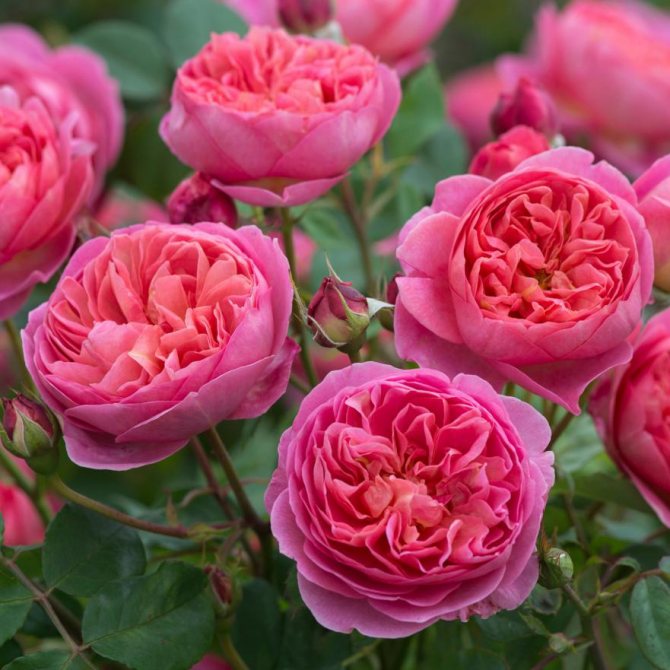

English roses look stylish in landscape design. Growing flowers is not difficult, although you will need to study all the varieties, and more and more new options are presented on the market. Roses William Shakespeare, Benjamin Britten, Graham Thomas, Abraham Darby, Scepter Isle are considered classics. Positive feedback on Rose Grace, Celebration Golden, Deren Elegantissima. They are all famous shrabs. By using the right mix of varieties, you can create a stylish catnip or carpet of flowers.
"Pilgrim"
Roses "Pilgrim" were bred in 1991 to breed this variety crossed "Graham Thomas" and "Elo Baton". Roses are unusually beautiful and unusual. The flower seems to glow from within. The glowing effect is due to the yellow center and white outer petals.
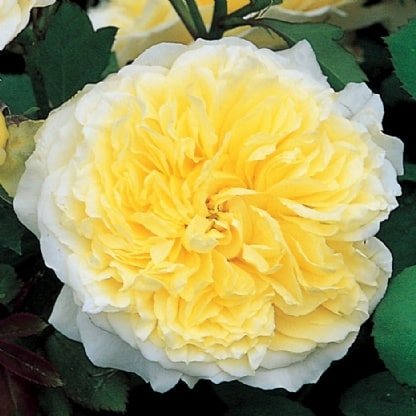

The flower reaches 8 centimeters in diameter. The bud is rosette-shaped, with perfectly folded petals. The aroma contains delicate notes of tea rose and myrrh.
The bushes reach a height of one and a half meters. They are erect and curvy. This variety has strong shoots and foliage of bright and rich color. Piligrim is cold and disease resistant.
Advantages and disadvantages
The creator notes that all plants meet the following requirements:
- the purity of the color of the petals;
- the strength of the scent;
- classic forms of buds;
- increased vitality.
The properties of Austin roses in different growing conditions may differ. The characteristics for central Russia are as follows.
- Frost resistance is higher than stated by the manufacturer.
- Plants often grow taller than indicated in the characteristics of the variety. This feature should be taken into account when planting, since replanting a 7-year-old bush will be problematic due to its size.
- When cultivating a rose as a climbing plant, you should also be prepared to grow longer shoots than indicated in the description.
- After planting a rose bush during the first two years, the flowers are small, the branches are weak, easily bending. At the end of the adaptation period, all indicators return to normal.
The main positive aspects of English roses:
- frost resistance;
- ease of care;
- the formation of flower buds along the entire length of the branch.
Disadvantages of some types:
- exactingness to weather conditions (rain, snow, hail, and so on);
- fragility of young branches under the weight of blossoming buds;
- dark-colored flowers tend to form black spots on the petals.

